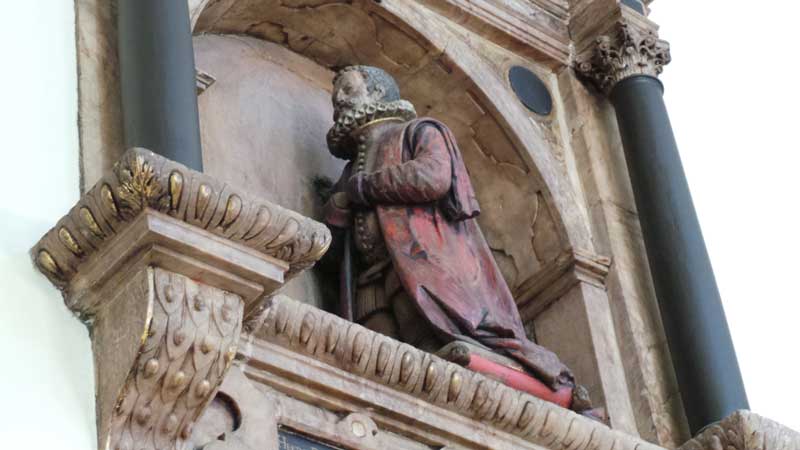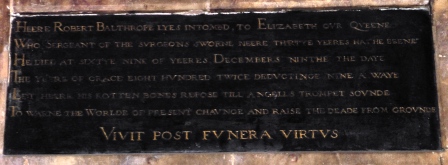
Inside the lovely little church of St Bartholomew the Less you will find the memorial to Robert Balthrope(1522-1591), a man who, in addition to being the "Sergeant to the Surgeons Sworn" to Queen Elizabeth 1st, appears to have also had an uncanny knack for collecting gowns.
When Balthrope was fifteen he became an apprentice surgeon to Nicholas Alcock, who was the surgeon to King Edward V1.
Evidently Alcock was impressed by young Balthrope, so much so that, following his death in 1550, he bequeathed him his "russet worsted gown trimmed with squirrel fur and velvet."
In 1561 the eminent surgeon Thomas Vicary died and left Balthrope his "best gown", together with his embroidered velvet coat and a silver syringe.
One thing's for certain about Robert Balthrope, by the time he reached his 40's he wasn't lacking for gowns!
But Balthrope's pursuits were not just of the sartorial variety. He seems to have been a gifted practitioner of the medicinal arts, and he hit the big one, surgically speaking, in 1562 when he was appointed Sergeant-Surgeon to Queen Elizabeth Ist, an office he evidently performed admirably as he held it for the rest of his life.
The first duty of a Sergeant-Surgeon was to follow his monarch onto the field of battle.
However, since the one place Elizabeth 1st wouldn't be seen dead on was a battlefield, Balthrope had to content himself with fulfilling his secondary duties, such as treating skin diseases, ailments and ulcers, all of which were regarded as coming under the remit of the Sergeant-Surgeon.
Another of his duties would have been to be present at the torture or maiming of state prisoners in order to ensure that the torture was not so prolonged that it endangered the victim's life. Where the punishment for a crime involved an amputation, the Sergeant-Surgeon had to ensure that the hemorrhage was staunched and the stump properly dressed. Who said the Tudor's were an uncaring bunch?
Balthrope would have also had the responsibility of screening applicants who were to be touched by the Monarch as a remedy for the King's Evil, or scrofula. Ever since the reign of Edward the Confessor (1003 - 1066) it was believed that the royal touch could cure this ailment - a form of TB that afflicted the glands of the neck - and regular services were held during which the reigning monarch would place a healing hand on those afflicted by the condition. Obviously it wouldn't be good for morale if, having been touched by the monarch, a patient died anyway - so the Sergeant-Surgeon would ensure that those due to be touched were not too far advanced in their condition, and that they stood a reasonable chance of surviving long enough for not too many embarrassing questions to be asked about the effectiveness of the remedy.
The Sergeant-Surgeons final duty, in the ultimate sense of the word, was the embalming of the royal corpse, a task Balthrope never got to avail himself of since he pre-deceased Elizabeth by twelve years.
In addition to an annual salary, Sergeant-Surgeons received other benefits.
They could, for example, draw "two buttes of sacke" from the royal wine cellars.
Should they be successful in curing their Monarch from a serious, or even a non serious, wound, their reward was to keep any bloodstained clothing as well as the dressings that had been used to staunch the flow of blood.
Robert Balthrope, apparently, did a satisfactory job and, when he died on December 9th 1591, he bequeathed his medicines, books, instruments, bottles, boxes, pots, and other surgical items to London's two hospitals for the sick and injured, St Bartholomew's and St Thomas's. Whether or not he left a gown to anyone is, sadly, not recorded
On 12th December 1591 he was buried inside the church of St Bartholomew-the-Less, the parish church of St Bartholomew's Hospital, where a handsome monument to his memory still adorns the wall above the organ.
He is shown resplendent in a fine red gown (what else?) with a smart ruff collar around his neck. He kneels on a stool, his eyes fixed upon some distant goal or long forgotten memory.
However, his inscription demonstrates a cunning solution to a problem that must have confronted epitaph writers since time immemorial (do you see what I did there?). What do you do if you're in the middle of composing an inscription and, try as you might, the muse just isn't upon you when it comes to rhyming the year of death with the day of death?

Here Robert Balthrope Lyes intombed,
to Elizabeth Our Queene
Who Sergeant of the Surgeons Sworne,
Neere Thirtye Yeeres Hathe Beene
He Died at Sixtye Nine of Yeeres,
Decembers Ninthe The Daye
The Yeere of Grace Eight Hundred Twice
Deductinge Nine A waye.
Let Here His Rotten Bones Repose
Till Angells Trompet Sounde
To Warne The Worlde of Present Chaunge
And Raise the Deade From Grounde.
Give that poet a gown!